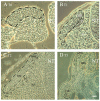Epithelial-Mesenchymal Transitions during Neural Crest and Somite Development
- PMID: 26712793
- PMCID: PMC4730126
- DOI: 10.3390/jcm5010001
Epithelial-Mesenchymal Transitions during Neural Crest and Somite Development
Abstract
Epithelial-to-mesenchymal transition (EMT) is a central process during embryonic development that affects selected progenitor cells of all three germ layers. In addition to driving the onset of cellular migrations and subsequent tissue morphogenesis, the dynamic conversions of epithelium into mesenchyme and vice-versa are intimately associated with the segregation of homogeneous precursors into distinct fates. The neural crest and somites, progenitors of the peripheral nervous system and of skeletal tissues, respectively, beautifully illustrate the significance of EMT to the above processes. Ongoing studies progressively elucidate the gene networks underlying EMT in each system, highlighting the similarities and differences between them. Knowledge of the mechanistic logic of this normal ontogenetic process should provide important insights to the understanding of pathological conditions such as cancer metastasis, which shares some common molecular themes.
Keywords: BMP; FGF; N-cadherin; Wnt; cell fate; cell migration; dermis; dermomyotome; neural tube; sclerotome.
Figures


References
-
- Le Douarin N.M., Kalcheim C. The Neural Crest. 2nd ed. Cambridge University Press; New York, NY, USA: 1999.
-
- Weston J.A. The migration and differentiation of neural crest cells. Adv. Morphog. 1970;8:41–114. - PubMed
Publication types
LinkOut - more resources
Full Text Sources
Other Literature Sources
Research Materials

